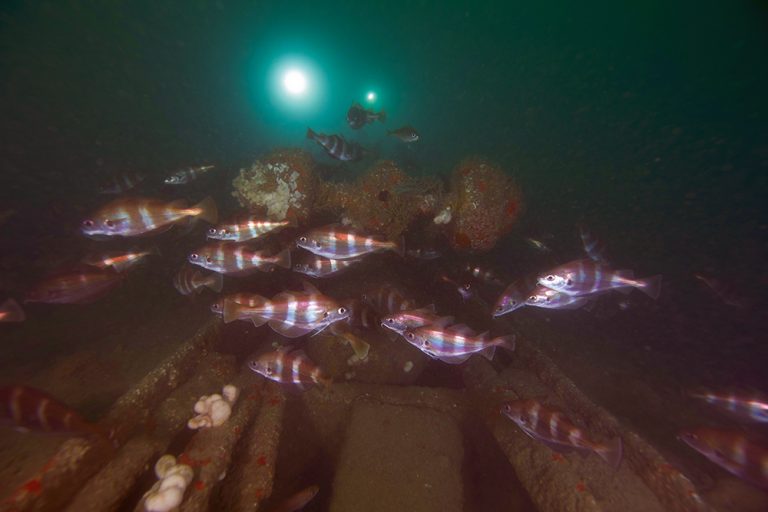- 1) EURO DIVER
- 2) Adapting to Covid-19 Travel Restrictions
- 3) Diving Normandy’s WW2 Wrecks
- 4) Van Troubles in Bayeux
- 5) Diving in the UK: Portland and Chesil Beach
- 6) Chesil Cove Dive Experience
- 7) The Impact of Covid-19 on the Diving Community
- 8) Diving in Pembrokeshire, Wales
- 9) The Isle of Coll: Basking Sharks and Dolphins
- 10) Diving in Lochs Duich and Carron
- 11) Exploring the Highlands and Flame Shell Reefs in Loch Carron
- 12) Encountering Grey Seals at the Farne Islands
- 13) Wrapping Up the Journey and Looking Ahead
EURO DIVER
For anyone who missed the first part of their journey, Swedish film-makers LINN VENNBERG and MATTIAS GRANBERG set off to tour Europe in their campervan, initially diving on Sweden’s own west coast. Then it was time to head south-west and start crossing borders
Mattias in Loch Carron.
Adapting to Covid-19 Travel Restrictions
It was time for us to leave Sweden, and the plan was to go straight to the UK through Germany and the Netherlands. However, Covid-19 and the restrictions that ensued had other plans for us.
Lockdown was just starting to be lifted in the UK, and a 14-day quarantine was established for everyone entering the country.
As we were allowed to transit only through Germany we stayed in the Netherlands, and when the borders to Belgium and France opened up continued down to Normandy to dive some of its WW2 wrecks.
Diving Normandy’s WW2 Wrecks
A diver from Bayeux dive-club offered to show us the diving in the area, and took us out to dive on the ss Empire Broadsword and Norfolk.
Unfortunately, although hot this wasn’t the best time of year for diving in the area and, combined with rainfall the day before, the visibility had been reduced to around 1m.
Despite this, we had two nice dives on these historically interesting wrecks, and can only imagine how enjoyable the experience would have been with decent visibility.
Van Troubles in Bayeux
As we were about to leave Bayeux our van started making worrying noises. Smoke billowed from the engine. Of course, it had to be the hottest day of our journey so far – 30°C.
Coincidentally, we were just outside a workshop. After being sent on to two other places we found one that had the required spare parts and were able to fix the vehicle without waiting days. That was the upside of having a French van breaking down in France.
While it was being repaired we and the two dogs set up camp in the shade outside, to the amusement of passers-by, and a couple of hours later we were on the road again.
Diving in the UK: Portland and Chesil Beach
On 10 July quarantine for people travelling from France to Britain was lifted, and we were finally able to cross the Channel and head for our first dive-stop there – Portland.
We dived from Chesil Beach, that popular spot for shore-diving, and also the submarine M2, which required a boat-ride out.
Chesil Cove Dive Experience
Chesil Cove is an easy dive that suits beginners as well as more experienced divers because there is a lot to see.
However it can be a challenge to get into the water, especially if there is a big swell, because you have to negotiate the pebble slope that gets very steep as you enter the water. And after the dive it’s just a matter of making your way back up the pebbles – probably easier with single tanks than with our twin-sets.
In theory sand-eels, lobsters, dogfish, crabs, cuttlefish and octopus can all be found at Chesil. We did two dives and unfortunately saw none of the above, apart from a cuttlefish that swam away as we started our descent!
The Impact of Covid-19 on the Diving Community
The M2 went down in Lyme Bay in 1932 along with all the crew and is designated as a war grave. It sits upright at 31-35m and is almost completely intact.
Despite what might be the first thought of many divers imagining a visit to a submarine there was a lot to see on deck, and besides being an interesting wreck much marine life too. Large conger eels peeked out of the many openings, and schools of fish swam around the wreck.
Diving with dive-centres and going out on dive-boats with other guests was when we really started to see the impact that Covid-19 was making on society.
Other than having to rearrange our travel plans and wear face-coverings at supermarkets it had not affected us that much in our day-to-day life until then. We had been largely keeping to ourselves and camping in fairly deserted places.
Diving in Pembrokeshire, Wales
But greeting new people with the elbow and wearing a face-covering on the way out to a dive-site is not how things are usually done, although it soon started to feel normal.
Some places we had wanted to dive had been fully booked by people whose trips abroad had been cancelled and who had turned to home-waters sites instead.
We hadn’t been able to book in advance, because we hadn’t known when quarantine would end.
When we arrived in the UK the dive-centres had only just begun to reopen, and shore-diving had been allowed for a couple of weeks.
The divers we met were all very happy to be back in the water.
Because of our delayed arrival we knew we would have to cut short our stay in the UK by a couple of weeks, so initially decided to skip Wales.
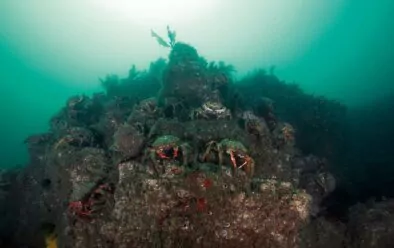
But after talking to a number of divers who said we shouldn’t miss diving in Pembrokeshire, we managed to fit in a couple of days’ shore-diving in Martin’s Haven – a decision we definitely didn’t regret.
This spot is an easy dive for all levels, although it can be a little trickier getting in at low tide if the swell is big.
Once in the water you just follow the wall and its forest of kelp at the top in either direction around the bay, or explore the sandy bottom in the middle.
During summer spider-crabs migrate to the coast from deeper waters to shed their shells and mate, and Martin’s Haven is one of the sites at which you can observe this phenomenon.
Watching several hundred crabs march over the seabed like an army was an impressive sight. Other than that we saw flatfish, dogfish, lobsters and bobtail squid during our night-dives.
The Isle of Coll: Basking Sharks and Dolphins
On our way to the Isle of Coll, one of our most exciting destinations, we drove through the amazing scenery of Snowdonia national park and up the west coast of England and Scotland to catch the ferry from Oban.
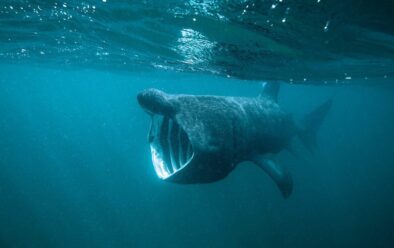
The next day we loaded our snorkel and camera equipment onto a boat and headed out around the Inner Hebrides to look for the filter-feeding giants that visit every summer – basking sharks.
The sea was a bit rough on the way out and, starting to feel a little seasick, I [Linn] decided to get some rest.
After a while a scream woke me: “Over there, a fin!” We had found the world’s second-largest fish.
We observed them for a while to see whether they were on the move or sticking around to feed, then started getting ready. Wetsuits were pulled on, cameras prepared and those who had not snorkelled before were told how to do it and what would happen.
There was even time for a quick jumping-in and swimming practice.
Once everyone felt comfortable we slowly approached the basking sharks to manoeuvre into the best position to jump in without rushing them.
Anticipation was high. The skipper gave us his “Go!” and we dropped into the water. I looked up to see a fin moving towards us, and quickly ducked to wait.
A shadow appeared ahead, and the next second a massive shark slowly cruised past, paying us no apparent attention.
Back in the boat we were all full of adrenaline from the good start to the day, and ready for another drop.
The sharks hung around to feed all day and we spent several hours like this, being dropped to watch them cruise past with their huge mouths agape as they filtered water through their gills, retaining the zooplankton.
Sometimes they would turn and swim past us several times or circle us before swimming away. We returned to harbour very happy.
We stayed on the Isle of Coll for a week, devoted another day to the basking sharks and were lucky enough to get a lot of good encounters, at least at the start of the day.
After a couple of hours they seemed to be moving away, and after searching for a while we were about to give up when we saw a fin in shallow water by a beach.
We approached slowly, slipped into the water and waited for the shark to come to us. Moments later a shadow swept over the white-sand bottom and passed right beneath me in the clear water, almost slapping me with its tail as it moved away.
With this rare and beautiful encounter we decided to call it a day and head back. On the way we heard reports of dolphins nearby and after heading in that direction suddenly found ourselves surrounded by hundreds of common dolphin jumping and playing around the boat. What a way to end two amazing days at sea!
Diving in Lochs Duich and Carron
A dive-trip to Scotland would not be complete without diving some lochs. We wanted to see the Isle of Skye so chose nearby lochs: Duich and Carron.
In Loch Duich the bottom is mostly mud and rock and the objective is mainly macro. We dived two sites over a couple of days, and the night dives especially provided interesting sightings.
We encountered bobtail and common squid, a thornback ray, various crabs, lots of long-clawed squat lobsters, sea pens, dogfish and gurnards.
At one site the bottom was covered in thousands of different-coloured brittlestars crawling over each other, a spectacular sight.
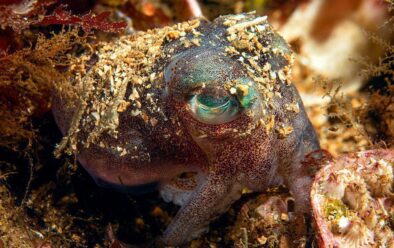
Loch Carron, beside being a good place to find interesting sea creatures, provided some beautiful scenery. At a site by the castle in North Strome the wall was covered in deadman’s fingers, and closer to the surface the kelp stood tall and flowed in the stream. We really enjoyed this beautiful gentle drift-dive.
Even more interesting, however, was what we found at the bottom. It wasn’t exhilarating at first glance, but looking more closely at what seemed to be a carpet woven of rocks and shells we could see its creators the flame shells peeking out from beneath it.
Loch Carron contains the world’s largest known flame shell reef, an important environment used by many different species to reproduce. Again the night-life was especially diverting, from bobtail squid to Yarrell’s blennies.
Exploring the Highlands and Flame Shell Reefs in Loch Carron
We took some time out driving around the highlands to take in their beauty as the end of our allotted time in the UK approached, but we did have one last dive destination planned before leaving the country.
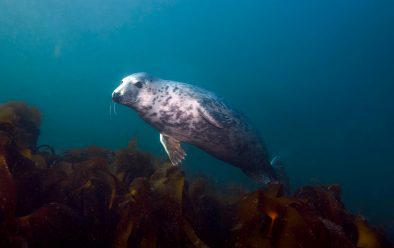
Encountering Grey Seals at the Farne Islands
We headed to the Farne Islands in hopes of getting acquainted with its famous inhabitants – the thousands of grey seals that live on its rocky shores.
We took the short boat-ride out to the islands from Seahouses harbour and almost immediately found seals lying in the sun on the cliffs. We spent a while watching them from the boat.
Now it was all about finding a good spot where the current was right for diving with the seals.
We found a good spot and jumped into the water. We descended along the kelp-covered wall and started swimming along it, heading for the canyon we had spotted from the boat.
For the second dive we had to find a new spot because the current had changed. The chosen site also had a canyon so we decided to go straight for it, which turned out to be a good decision.
The seals were just as playful on this dive, and not only our fins but also the cameras were inspected inquisitively.
Several seals came up to nibble my strobes, and even the protection around the domes on both our cameras. We had so much fun playing with them that the dive seemed to be over way too soon.
Wrapping Up the Journey and Looking Ahead
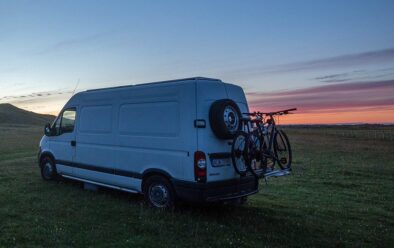 After that more-than-satisfactory conclusion to this leg of our journey, all that remained was to drive down to Dover to catch the ferry back to France.
After that more-than-satisfactory conclusion to this leg of our journey, all that remained was to drive down to Dover to catch the ferry back to France.
The idea was to do some more wreck-diving, we hoped with better visibility than before, before continuing to our next destination – Portugal.
